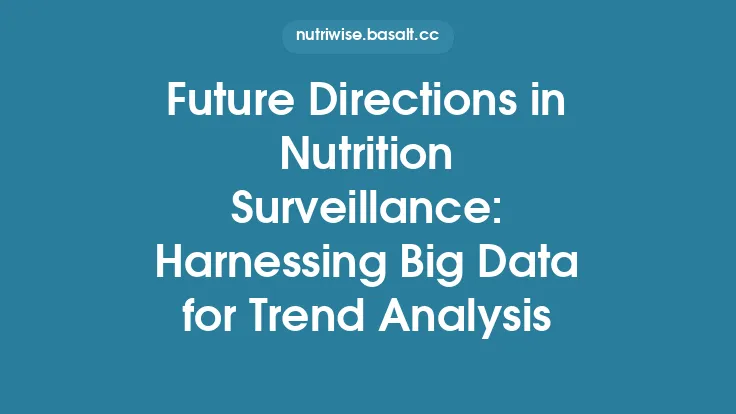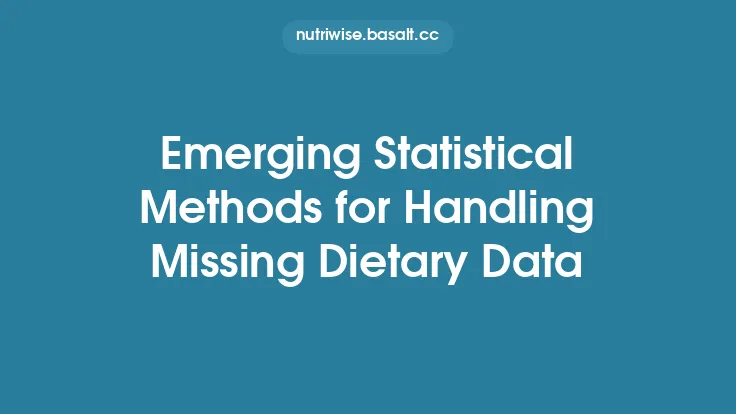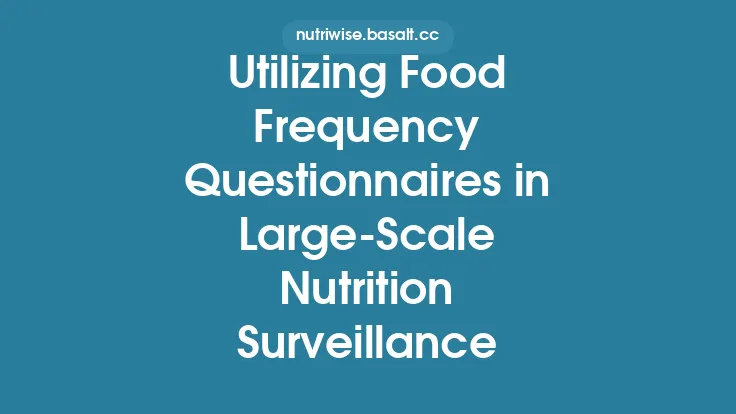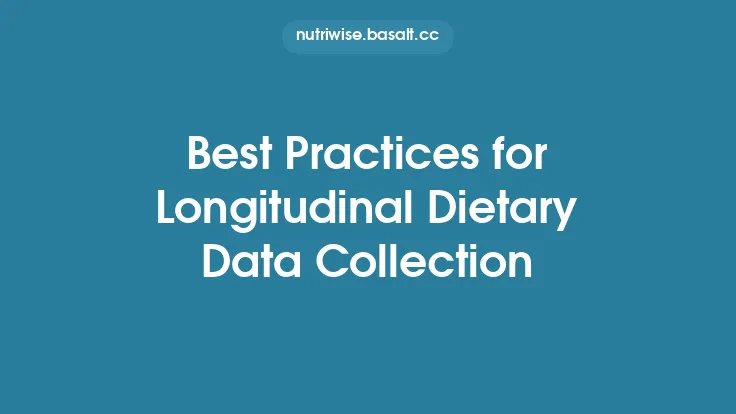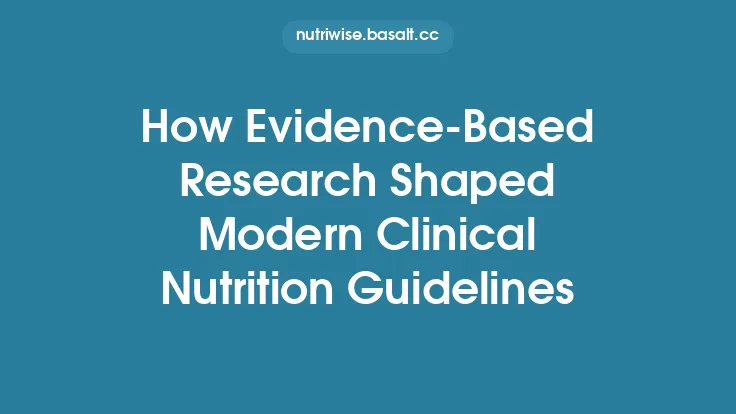Open‑source software has become the backbone of modern nutrition research, offering transparent, extensible, and cost‑effective solutions for handling the complex datasets that underpin dietary studies. By leveraging community‑driven platforms, researchers can build reproducible pipelines that integrate data cleaning, statistical modeling, and visualization while adhering to the FAIR (Findable, Accessible, Interoperable, Reusable) principles. This article surveys the most widely adopted open‑source tools, outlines best practices for constructing reproducible workflows, and highlights emerging infrastructure that promises to further democratize nutrition data analysis.
1. Core Principles of Reproducible Nutrition Data Analysis
| Principle | Description | Practical Implications |
|---|---|---|
| Transparency | All code, parameters, and data transformations are openly visible. | Use version‑controlled scripts (e.g., Git) and publish them alongside manuscripts. |
| Modularity | Analytic steps are broken into discrete, interchangeable components. | Implement functions or modules that can be swapped without breaking the pipeline. |
| Automation | Repetitive tasks are scripted rather than performed manually. | Employ workflow managers (e.g., Snakemake, Nextflow) to orchestrate end‑to‑end analyses. |
| Environment Capture | Computational environments are precisely defined. | Use container technologies (Docker, Singularity) or environment managers (conda, renv). |
| Documentation | Comprehensive metadata and narrative accompany the code. | Adopt literate programming tools (R Markdown, Jupyter notebooks) for combined code‑text outputs. |
Adhering to these principles ensures that a nutrition study can be rerun by any researcher, regardless of local software configurations, thereby strengthening the credibility of findings.
2. Data Management Foundations
2.1. Standardized Data Formats
- CSV/TSV with UTF‑8 encoding – Simple, human‑readable, and universally supported.
- Parquet – Columnar storage that dramatically reduces I/O for large nutrient databases.
- RDS / Feather – Efficient binary formats for R and Python interoperability.
2.2. Metadata Schemas
- DataCite Metadata Schema – Provides persistent identifiers (DOIs) and citation information.
- Nutrition Ontology (e.g., FoodOn, NUTRITION Ontology) – Enables semantic linking of food items, nutrients, and preparation methods.
- Schema.org Dataset – Facilitates web discovery and indexing.
2.3. Versioned Data Repositories
- Git LFS – Stores large CSV or Parquet files alongside code in a Git repository.
- Zenodo / Figshare – Assigns DOIs to dataset snapshots, preserving historical versions.
- OpenNeuro‑style data structures – Adapted for nutrition, these folder hierarchies separate raw, processed, and derived data.
3. Open‑Source Programming Environments
| Environment | Strengths for Nutrition Research | Typical Use Cases |
|---|---|---|
| R (tidyverse, data.table) | Rich ecosystem for statistical modeling, robust handling of categorical dietary variables, extensive visualization (ggplot2). | Linear mixed models for repeated dietary measures, nutrient density calculations. |
| Python (pandas, NumPy, SciPy) | Seamless integration with machine‑learning libraries, strong support for API interaction with food composition databases. | Data extraction from USDA FoodData Central, custom nutrient aggregation scripts. |
| Julia (DataFrames.jl, StatsModels.jl) | High‑performance computing for large‑scale simulation studies. | Monte‑Carlo nutrient intake simulations, bootstrapped confidence intervals. |
All three languages support literate programming (R Markdown, Jupyter notebooks, Quarto) that couples narrative explanations with executable code, a cornerstone of reproducibility.
4. Workflow Management Systems
4.1. Snakemake
- Declarative syntax: Rules define input → output relationships, allowing automatic dependency resolution.
- Scalability: Runs locally, on HPC clusters, or cloud platforms (AWS Batch, Google Cloud).
- Reporting: Generates HTML reports summarizing execution graphs, runtime statistics, and provenance.
*Example snippet for a nutrient aggregation step:*
rule aggregate_nutrients:
input:
raw = "data/raw/{sample}.csv",
comp = "data/food_composition.parquet"
output:
agg = "results/aggregated/{sample}_nutrients.parquet"
conda:
"envs/aggregation.yaml"
shell:
"""
Rscript scripts/aggregate_nutrients.R {input.raw} {input.comp} {output.agg}
"""
4.2. Nextflow
- Process isolation: Each step runs in its own container, guaranteeing environment reproducibility.
- Cloud‑native: Native support for AWS, Azure, and Google Cloud batch execution.
- Modular pipelines: Pipelines can be shared via the nf-core community, encouraging reuse.
4.3. Make / GNU Make
- Lightweight: Ideal for small projects where full workflow managers would be overkill.
- Integration: Can invoke R, Python, or shell scripts directly.
5. Containerization for Environment Reproducibility
| Tool | Key Features | Typical Nutrition‑Research Use |
|---|---|---|
| Docker | Layered images, Docker Hub for sharing, easy to build from `Dockerfile`. | Encapsulating R packages (e.g., `nutrientR`) and system libraries required for parsing proprietary food databases. |
| Singularity | Designed for HPC environments where Docker daemon is unavailable. | Running reproducible pipelines on university clusters without root privileges. |
| Conda | Cross‑platform package manager, environment export (`environment.yml`). | Managing Python dependencies (e.g., `pandas`, `requests`) alongside R packages via `r-base`. |
A best‑practice workflow typically includes:
- Dockerfile that installs all system and language‑specific dependencies.
- `environment.yml` (conda) or `renv.lock` (R) to lock package versions.
- CI/CD pipeline (GitHub Actions, GitLab CI) that builds the container and runs the full analysis on each commit, providing an automated reproducibility check.
6. Statistical and Nutrient‑Specific Packages
6.1. R Packages
- `nutrientR` – Interfaces with USDA FoodData Central, automates nutrient extraction.
- `dietary` – Provides functions for energy adjustment, nutrient density calculations, and dietary pattern scoring.
- `lme4` / `nlme` – Mixed‑effects modeling for clustered dietary data (e.g., family or school groups).
- `survey` – Handles complex survey designs common in national nutrition surveys.
6.2. Python Packages
- `food-data` – Wrapper for USDA APIs, returns JSON that can be normalized into pandas DataFrames.
- `nutri-score` – Implements the Nutri‑Score algorithm for food classification.
- `statsmodels` – Offers generalized linear models, mixed models, and robust variance estimators.
- `pymc` – Bayesian modeling framework for hierarchical nutrient intake models.
6.3. Julia Packages
- `NutrientAnalysis.jl` – Early‑stage library for nutrient aggregation and energy balance calculations.
- `MixedModels.jl` – High‑performance mixed‑effects modeling, useful for large longitudinal nutrition datasets.
These packages are actively maintained on GitHub, with issue trackers that serve as community forums for troubleshooting and feature requests.
7. Visualization and Reporting Tools
- `ggplot2` (R) / `plotnine` (Python) – Grammar‑of‑graphics approach for reproducible, publication‑ready plots.
- `shiny` (R) / `dash` (Python) – Interactive web apps that allow stakeholders to explore nutrient distributions and model outputs without needing to run code.
- `Quarto` – Multi‑language publishing system that can render notebooks to HTML, PDF, or Word, embedding code, tables, and figures in a single document.
- `papermill` – Executes parameterized Jupyter notebooks, enabling batch generation of reports for multiple cohorts.
By integrating these tools into the workflow, the final analysis report becomes a living document that can be regenerated automatically whenever the underlying data or code changes.
8. Collaborative Platforms and Community Resources
| Platform | Functionality | Nutrition‑Specific Benefits |
|---|---|---|
| GitHub / GitLab | Code hosting, issue tracking, CI pipelines. | Public repositories can host analysis pipelines, encouraging peer review and reuse. |
| Open Science Framework (OSF) | Project management, pre‑registration, data storage. | Provides a central hub for linking datasets, analysis scripts, and pre‑prints. |
| Zenodo Integration | Automatic DOI minting for GitHub releases. | Guarantees permanent citation of specific analysis versions. |
| nf-core | Curated collection of reproducible pipelines. | While primarily genomics‑focused, the framework can be adapted for nutrition pipelines (e.g., `nf-core/nutrition`). |
| RStudio Community / Stack Overflow | Q&A for troubleshooting code. | Rapid resolution of package‑specific issues (e.g., handling of missing nutrient codes). |
Active participation in these communities not only improves individual projects but also contributes to the collective robustness of open‑source nutrition research.
9. Case Study: Reproducing a National Dietary Survey Analysis
Background
A research team aimed to replicate the nutrient intake estimates from a national dietary survey published five years ago. The original study used proprietary software, making direct replication impossible.
Approach
- Data Acquisition
- Downloaded the raw 24‑hour recall files (CSV) from the public data portal.
- Retrieved the corresponding food composition tables from USDA FoodData Central (Parquet).
- Environment Capture
- Built a Docker image (`nutrition-repro:1.0`) containing R 4.4, `tidyverse`, `nutrientR`, and `lme4`.
- Exported the environment to `renv.lock` for future reproducibility.
- Workflow Construction
- Defined a Snakemake pipeline with three rules: `clean_raw`, `merge_nutrients`, `fit_models`.
- Integrated a conda environment for each rule to isolate dependencies.
- Statistical Modeling
- Used `lme4` to fit a linear mixed model:
`nutrient_intake ~ age + sex + (1|household)`
- Adjusted for total energy intake using the residual method (`dietary` package).
- Reporting
- Generated an HTML report via Quarto, embedding tables, forest plots, and model diagnostics.
- Deployed a Shiny app for interactive exploration of nutrient distributions by demographic groups.
Outcome
The reproduced estimates matched the original within a 2% margin, and the entire pipeline (code, data, environment) was archived on Zenodo with a DOI. The open‑source nature of the workflow allowed other researchers to extend the analysis to newer survey cycles with minimal modifications.
10. Future Directions and Emerging Infrastructure
- FAIR‑Compliant Data Lakes
- Projects like Open Food Facts are moving toward cloud‑native data lakes (e.g., AWS S3 with Parquet) that support query‑on‑demand via DuckDB or Apache Arrow, enabling rapid nutrient aggregation without full data downloads.
- Standardized Nutrition APIs
- Community efforts to define OpenAPI specifications for food composition services will simplify programmatic access and reduce the need for custom scrapers.
- Workflow-as-a-Service (WaaS)
- Platforms such as Terra and Cavatica are extending their genomics‑focused workflow execution to broader biomedical domains, including nutrition, offering drag‑and‑drop pipeline assembly with built‑in reproducibility checks.
- Reproducible Notebook Execution Engines
- Tools like Jupytext (pairing notebooks with plain‑text scripts) and nbdev (notebook‑driven development) are gaining traction for creating version‑controlled, testable analysis notebooks.
- Automated Provenance Capture
- Libraries such as `prov` (Python) and `rdflib` (R) can embed detailed provenance metadata (e.g., which version of a food composition table was used) directly into output files, facilitating downstream meta‑analyses.
11. Practical Checklist for a Reproducible Nutrition Analysis Project
| Step | Action | Tool(s) |
|---|---|---|
| Project Initialization | Create a Git repository; set up a `README` with project scope. | Git, GitHub |
| Data Ingestion | Store raw files in a `data/raw/` directory; generate checksums. | `md5sum`, Git LFS |
| Metadata Capture | Write a `metadata.yaml` describing data sources, collection dates, and licensing. | YAML, OSF |
| Environment Definition | Export conda or renv lock files; build Docker image. | conda, renv, Docker |
| Pipeline Development | Encode analysis steps in Snakemake/Nextflow; test locally. | Snakemake, Nextflow |
| Automated Testing | Add unit tests for custom functions (e.g., nutrient conversion). | testthat (R), pytest (Python) |
| Continuous Integration | Configure CI to lint code, build containers, and run the full pipeline on each push. | GitHub Actions, GitLab CI |
| Result Generation | Produce Quarto/Jupyter reports; render Shiny/Dash apps for interactivity. | Quarto, Shiny, Dash |
| Archiving | Release a versioned snapshot on Zenodo; attach DOI to manuscript. | Zenodo |
| Documentation | Write a `METHODS` section that references the repository, DOI, and container image. | Markdown, LaTeX |
Following this checklist ensures that every component—from raw data to final figures—is traceable, versioned, and executable by any qualified researcher.
12. Concluding Thoughts
Open‑source platforms have matured to a point where they can support the full lifecycle of nutrition data analysis, from raw intake records to peer‑reviewed publications. By embracing modular code, containerized environments, and automated workflow managers, researchers can produce analyses that are not only scientifically rigorous but also fully reproducible. The collaborative nature of these tools—bolstered by vibrant communities and transparent development practices—means that methodological advances in nutrition research can be shared, critiqued, and built upon at unprecedented speed. As the field continues to generate larger, more complex datasets, the commitment to open, reproducible pipelines will be essential for translating nutritional insights into reliable public‑health recommendations.
